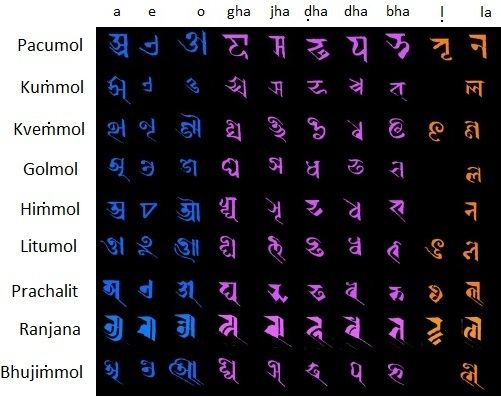Type Abugida | Languages Nepal Bhasa | |
 | ||
Parent systems Proto-Sinaitic script
Phoenician alphabet
Aramaic script (?)
Brāhmī
Gupta
Nepalese scripts | ||
The Nepalese scripts are alphabetic writing systems of Nepal. They have been used primarily to write both the national Indo-European language of Nepali plus some Tibeto-Burman languages such as Newari (also known locally as Nepal Bhasa).
Contents
The older alphabets, known as Brahmic scripts, were in widespread use from the 10th to the early 20th century A.C.E., but have since been largely supplanted by the modern script known as Devanagari. Of the older scripts, about 50,000 manuscripts written in Nepal Lipi have been archived.
Outside of Nepal, Brahmi scripts also have been used to write Sanskrit, Hindi, Maithili, Bengali and Braj Bhasha languages. They have reportedly been used to inscribe mantras on funerary markers as distant as Japan as well.
Early History
Nepal or Nepalese script appeared in the 10th century. The earliest instance is a manuscript entitled Lankavatara Sutra dated Nepal Era 28 (908 AD). Another early specimen is a palm-leaf manuscript of a Buddhist text the Prajnaparamita, dated Nepal Era 40 (920 AD). One of the oldest manuscript of Ramayana, preserved till date, was written in Nepal Script in 1041.
The script has been used on stone and copper plate inscriptions, coins (Nepalese mohar), palm-leaf documents and Hindu and Buddhist manuscripts.
Among the different scripts based on Nepal script, Ranjana (meaning "delightful"), Bhujinmol ("fly-headed") and Prachalit ("ordinary") are the most common.
Ranjana is the most ornate among the scripts. It is most commonly used to write Buddhist texts and inscribe mantras on prayer wheels, shrines, temples and monasteries. The popular Buddhist mantra Om mani padme hum (meaning ("Hail to the jewel in the lotus" in Sanskrit) is often written in Ranjana.
Besides the Kathmandu Valley and the Himalayan region in Nepal, the Ranjana script is used for sacred purposes in Tibet, China, Japan, Korea, Mongolia, Bhutan, Sikkim and Ladakh.
The Jokhang Temple in Lhasa, Tibet is ornamented with mantras embossed in Ranjana script, and the panels under the eaves are numbered using Nepal Lipi.
Among the famed historical texts written in Nepal Lipi are Gopalarajavamsavali, a history of Nepal, which appeared in 1389 AD, the Nepal-Tibet treaty of Nepal Era 895 (1775 AD) and a letter dated Nepal Era 535 (1415 AD) sent by Chinese Emperor Tai Ming to Shakti-simha-rama, a feudatory of Banepa.
Types
The different scripts derived from Nepal script are as follows:
Decline
Nepalese scripts saw widespread use for a thousand years in Nepal. In 1906, the Rana regime banned Nepal Bhasa, Nepal Era and Nepal Lipi from official use as part of its policy to subdue them, and the script fell into decline.
Authors were also encouraged to switch to Devanagari to write Nepal Bhasa because of the availability of moveable type for printing, and Nepal Lipi was pushed further into the background. However, the script continued to be used in religious and ceremonial purposes till the 1950s.
Revival
After the Rana dynasty was overthrown and democracy established in 1951, restrictions on Nepal Bhasa were lifted. Attempts were made to study and revive the old scripts, and alphabet books were published. Hemraj Shakyavamsha published an alphabet book of 15 types of Nepalese alphabets including Ranjana, Bhujimol and Pachumol.
In 1952, a pressman Pushpa Ratna Sagar of Kathmandu had moveable type of Nepal script made in India. The metal type was used to print the dateline and the titles of the articles in Thaunkanhe monthly.
In 1989, the first book to be printed using a computer typeface of Nepal script, Prasiddha Bajracharyapinigu Sanchhipta Bibaran ("Profiles of Renowned Bajracharyas") by Badri Ratna Bajracharya, was published.
Today, Nepal Lipi has gone out of general usage, but it is sometimes used in signage, invitation and greeting cards, letterheads, book and CD covers, product labels and the mastheads of newspapers. A number of private organizations are engaged in its study and promotion.
Nepal Lipi (with the name “Newa”) was approved for inclusion in Unicode 9.0.
